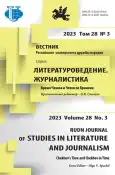The imaginary doctor and his speech mask in the works of A.P. Chekhov and in Russian humorous literature at the end of the 19th century
- 作者: Kubasov A.V.1
-
隶属关系:
- Ural State Pedagogical University
- 期: 卷 28, 编号 3 (2023): Chekhov’s Time and Chekhov in Time
- 页面: 427-436
- 栏目: LITERARY CRITICISM
- URL: https://journal-vniispk.ru/2312-9220/article/view/319057
- DOI: https://doi.org/10.22363/2312-9220-2023-28-3-427-436
- EDN: https://elibrary.ru/QZBXOJ
- ID: 319057
如何引用文章
详细
The proposed study delves into the depiction of an imaginary doctor in mass humor during the late 19th century and in Chekhov’s early work. Its aim is to provide an explanation for Chekhov’s innovative humor, which stands out in comparison to that of his contemporaries. The work’s scientific novelty lies in the clarification of the concept of “speech mask in literature”. This refers to a hybrid of two languages, one inherent to the hero and the other appropriated from someone else, presented in a dialogic manner. Chekhov’s contemporaries such as Leikin, Amfiteatrov, and Shcheglov created simplistic comic scenarios in their works. The intentions of these authors were aimed solely at entertaining and distracting readers from their daily worries. Chekhov takes a complex stance on mass humor. On one hand, he must adhere to its demands in order to publish his stories in magazines. On the other hand, he subverts existing conventions by complicating his heroes’ speech characteristics through a speech mask. Chekhov not only entertains his readers, but also provides depictions of provincial customs and various social types. The image of the doctor in Chekhov’s mature works is ambivalent and only indirectly related to the imaginary doctor from his humorous pieces.
作者简介
Alexander Kubasov
Ural State Pedagogical University
编辑信件的主要联系方式.
Email: kubas2002@mail.ru
ORCID iD: 0000-0001-9074-1133
Doctor of Philology, Professor, Head of the Department of Theory and Methods of Teaching Persons with Disabilities
26 Prospekt Kosmonavtov, Ekaterinburg, 620017, Russian Federation参考
- Amfiteatrov, A.V. (1886). How we are treated. Alarm Clock, (32), 377-379. (In Russ.)
- Bogdanov, K.A. (2005). Doctors, patients, readers: Pathographic texts of Russian culture in the 18-19th centuries. Moscow: OGI Publ. (In Russ.)
- Bortkevich, V.O. (1902). Paramedic and paramedicism. Encyclopedic Dictionary of Brockhaus and Efron, XXXV, 442-443. (In Russ.)
- Chebotnikova, T.A. (2011) Speech behavior of a person in the discourse of a work of art: Roles, masks, images. Orenburg: Publishing House of the Pedagogical University. (In Russ.)
- Chekhov, A.P. (1974-1982). Complete works and letters. Moscow: Nauka Publ. (In Russ.)
- Coulmas, F. (2019). Identity in literature. New York: Oxford University Press.
- Dal, V.I. (1989). Explanatory dictionary of the living Great Russian language. Moscow: Russkii yazyk Publ. (In Russ.)
- Kubasov, A.V. (2018). Genderlect in Chekhov's dramatic sketch “The Night Before Judgment”. Ural Philological Bulletin. Russian Classics: The Dynamics of Artistic Systems, (4), 77-87. (In Russian)
- Kuks, A.V. (2010). Construction of a speech mask in game discourse (abstract of the dissertation of the Candidate of Philological Sciences). Tomsk. (In Russ.)
- Leikin, N.A. (1881). Geese are pawed. St. Petersburg: Tip. d-ra Khana Publ. (In Russ.)
- Lotman, Yu.M. (1979). Speech mask Drooling. Secondary Modeling Systems (pp. 88-90). Tartu: University of Tartu. (In Russ.)
- Mangold, M. (2020). Chekhov’s environmental psychology: Medicine and the early stories. Slavic Review, 79(4), 709-730. https://doi.org/10.1017/slr.2021.8
- Shcheglov, I. (1901). Cheerful theater. St. Petersburg: A.S. Suvorin Publ. (In Russ.)
- Shpilman, M.V. (2006). Communication strategy “speech mask” (based on the works of A. and B. Strugatsky) (abstract of the dissertation of the Candidate of Philological Sciences). Novosibirsk. (In Russ.)
- Vvedensky, Ars. (1890). Сontemporary literary figures. Nikolai Alexandrovich Leikin. Historical Bulletin, XL, 634-643. (In Russ.)
补充文件









